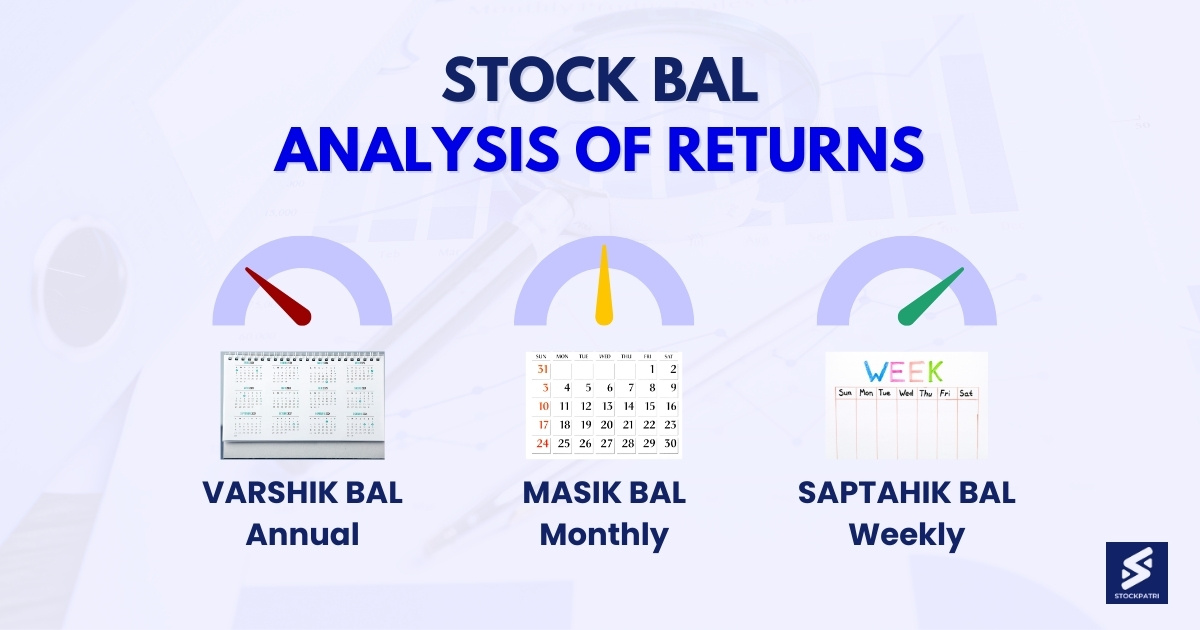StockBal – A First For The Indian Market
You have probably already used or seen StockBal, which is StockPatri’s proprietary measure of relative strength of all NSE traded stocks across multiple time-frames. It is probably the first such index that is updated after the end of each trading session, and available in a dashboard for the retail investors and traders.
We have been inspired by the purpose of leveling the playing field for the retail participants in the market, most of whom end up losing money. In line with our approach, we launched our platform in October 2024 with our first innovative product, StockBal. This launch spiked a lot of curiosity among the retail participants, and within few days of our launch, our platform welcomed visitors from over 100 cities!
There are a lot of questions in the mind of someone looking at the StockBal Index for the first time. Many such questions relating to the concept, computation and usage of the StockBal have already been answered on the StockBal Dashboard page itself. However, one set of questions, in particular, need a more detailed response.
So, we are here to talk about the results of our analysis correlating market returns with various levels of the StockBal Index.
StockBal – A Brief Recap
Let’s dive right into the topic at hand, and start with a brief re-cap of the StockBal. You can skip / collapse this section, in case you are already aware of the same.
What is StockBal?
StockBal is not just any index; it’s a game-changer! We measure the relative strength of all NSE traded stocks across three time frames on a scale of 0-100. The Varshik Bal, Masik Bal and Saptahik Bal measure the Bal or strength of a stock compared to the overall market over three different time -frames – Annual, Monthly and Weekly.
A lower score implies that the stock is not performing well compared to the market for the given time-frame. This StockBal Dashboard gives you a comprehensive view of stock performance over different periods, helping you navigate the often emotional roller coaster of the stock market with confidence.
Where can I view the StockBal Dashboard?
You can view the StockBal on this dashboard, and it is updated after the end of each trading session. The timings may vary slightly, but it is typically updated by 7PM IST on each trading day.
Which stocks are covered by the StockBal?
The StockBal is computed for all stocks that are traded on the National Stock Exchange (NSE). In case a stock has not yet been trading for a year, the Varshik Bal will obviously not be available, but we will still be publishing the StockBal for the shorter durations, such as MasikBal and Saptahik Bal, if the stock has been trading for such duration.
We currently do not cover the stocks that are listed on the BSE or regional stock exchanges. If you want us to include those stocks, or if you have any other suggestion or feedback, please head over to the Suggestion and Feedback form. We will be delighted to hear from you, and incorporate your suggestions in our roadmap.
Your Questions About StockBal
The Indian stock market is overflowing with data, and yet StockBal stands out as a first-of-its-kind tool. It provides a clear, straightforward measure of stock strength, enabling you to make decisions based on data rather than speculation or heresay. But this innovation naturally leads to several questions:
- What impact does StockBal have?
- Which time horizon should one focus on?
- Which choice of parameters to filter StockBal yields the highest return?
- Why should we believe you? Can these claims be backed by historical data?
We’ve Done the Analysis…
…so That You Don’t Have To
We’re excited to share the results of the analysis that we have done to answer these questions.
Analysis Objectives and Methodology
The StockBal index is intended to capture relative strength compared to the broader market, Hence, the stock-wise results have been compared with the results of the broader market. In doing so, we have take the NSE 500 index as a surrogate for the broader market, instead of the more popular NIFTY (or NSE-50).

The returns of the market have been computed based on the maximum potential returns of the median stocks in the NSE 500 bucket over a 10 day trading window.
We have used the median instead of the mean for all our computations, since it is a better representation of the broader market.
Our objective is to maximize the surface area i.e. the probability and the quantum of potential gains.
Hence, we have used the difference between the next 10 days High Price of a stock and the Closing Price on the reference date to compute the market return, and also the returns from the selection of stocks.
Please note that there is no back-testing involved, since there is no recommended trading strategy.
The Results Are In
The Baseline

Before we analyze the results based on the StockBal, it is important to establish the baseline.
For the given duration of the previous two months, the maximum potential return of the median stock in the broader market was 4.58% over the 10 trading day window.
This does seem like an eye-popping return, particularly if you are doing some quick mental maths and trying to annualize this!
However, please note that this is based on the maximum potential return, and it is improbable for any trader or investor to catch the highs all the time.
This approach implies that we are increasing our benchmark or target to astronomical levels that appear to be difficult to beat. However, this is the right thing to do, since our objective right now is to maximize the surface area and the probability of our gains, using StockBal as a tool.
If you are building trading strategies based on this StockBal index, the same should be back-tested separately. If you need assistance or have queries related to this, please reach out to us.
Now that we have established the benchmark number of 4.58% potential returns, let us see if the right selection of stocks based on the StockBal could have beaten this baseline number. Game On!
Analysis Of Returns Based On StockBal
VarshikBal – Higher Is Better
The Varshik Bal holds a lot of influence on the potential to generate returns, even though the trading day window is quite small, at 10 days. As we often hear in the market, the trend is indeed your friend!
Stocks trading in the High zone of the Varshik Bal have yielded much higher potential of returns. The returns have been computed in the same manner that we computed the returns for the broader market, but only for the selection of stocks where Varshik Bal is in the High, Medium and Low zone respectively.

We found that stocks trading in the High Varshik Bal zone yielded a maximum potential return of 5.26%, as compared to the benchmark return of 4.58% over the 10 day trading window. This represents almost 15% higher potential of returns than the broader market.
However, the broader market includes these stocks in the High Varshik Bal Zone.
So, the correct comparison is with the return of 4.24% of all stocks in the Low and Medium Varshik Bal zone (i.e. stocks that are not trading in the High Varshik Bal zone).
In simple terms, this means that if you picked a stock blindly, your typical (median) pick would have a potential of 4.58% returns. However, if you picked a stock with High Varshik Bal, the potential increased from 4.24% to 5.26%, a whopping increase of 24%!
You can think of this as the percentage by which you have increased the surface area of your luck, by simply picking stocks with a High Varshik Bal.
Best of Varshik Bal, Masik Bal and Saptahik Bal
Let us extend this a little further. What if we were to select stocks with all three StockBal values in the High zone? For our period of analysis, we found that the stocks with High Varshik Bal and High Masik Bal and High Saptahik Bal, had a maximum potential return of 5.79%.

These returns are 26% higher than the broader market returns, and as you have seen earlier, the effective percentage will be almost 30% if we exclude the stocks with high values across all three variations of the StockBal from the broader market.
In simple terms, this means that if you picked a stock with High Varshik Bal and High Masik Bal and High Saptahik Bal, the potential returns increased from 4.47% to 5.79%, a whopping increase of 29.5%!
You can think of this as the percentage by which you have increased the surface area of your luck, by simply picking stocks with High StockBal across all three time-frames – high Varshik Bal, high Masik Bal and high Saptahik Bal.
However, does this mean that stocks with Low StockBal do not have the potential to yield returns?
Do Stocks With Low StockBal Give Returns Too?

As one would intuitively expect, the stocks with a Low Varshik StockBal are less likely to generate a higher potential of returns.
However, the StockBal computed in a shorter weekly time frame does not follow these rules.
We have found that stocks with a High Varshik Bal, but a Low Saptahik Bal, demonstrated a potential of 5.58% returns, which is 25% higher than the 4.45% return from other stocks.
This may appear counter-intuitive at first, but there is a plausible logical explanation.
Stocks that have demonstrated strong performance during the year, but have been weak over the last few trading sessions, are likely to bounce back.
Should I Trade Based On StockBal?
How would you answer this question for any other tool, indicator, or index? No trading approach or strategy can guarantee results. Our approach at StockPatri is to provide you data-driven insights, and to help you increase the probability, and the surface area, of your potential profits.
Please note all our disclaimers, and in particular, please do not treat the above as investment advice, and remember that historical pattern, performance or behavior of any tool, index or indicator, may not repeat itself in the future.
The Final Word: Power of Compounding
The returns computed in the above analysis are over short durations, and even a seemingly minor increase in returns over a 10 trading day window, when earned twice a month for 12 months in a year, and repeated consistently over several years can help you re-write your financial patri, and indeed change the course of your life.
Explore the StockBal Dashboard now!
Note: Stock market investments are subject to market risks. Past performance is not indicative of future results. The above should not be treated as investment advice. Please read the full disclaimers here.

